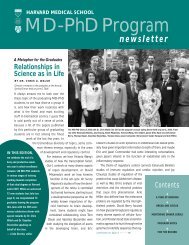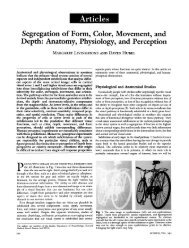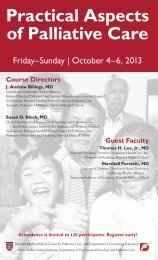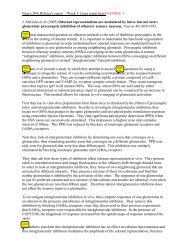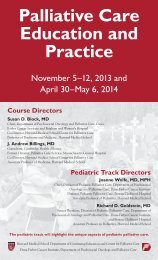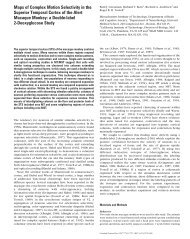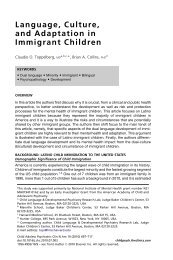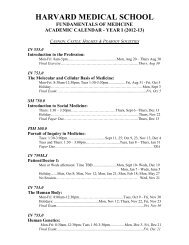Differential Diagnosis of Selective Mutism in Bilingual Children
Differential Diagnosis of Selective Mutism in Bilingual Children
Differential Diagnosis of Selective Mutism in Bilingual Children
- No tags were found...
Create successful ePaper yourself
Turn your PDF publications into a flip-book with our unique Google optimized e-Paper software.
CLINICAL PERSPECTIVES Associate Editor: Michael S. Jell<strong>in</strong>ek, M.D.<strong>Differential</strong> <strong>Diagnosis</strong> <strong>of</strong> <strong>Selective</strong> <strong>Mutism</strong><strong>in</strong> Bil<strong>in</strong>gual <strong>Children</strong>CLAUDIO O. TOPPELBERG, M.D., PATTON TABORS, ED.D., ALISSA COGGINS, PSY.D., KIRK LUM, M.D.,AND CLAUDIA BURGER, B.A.Early diagnosis <strong>of</strong> selective mutism (SM) is an importantconcern. SM prevalence is higher than <strong>in</strong>itiallythought and at least three times higher <strong>in</strong> immigrantlanguage m<strong>in</strong>ority children. Although the DSM-IV precludesdiagnos<strong>in</strong>g SM <strong>in</strong> immigrant children with limitedlanguage pr<strong>of</strong>iciency (as children acquir<strong>in</strong>g a secondlanguage may normally undergo a ‘‘silent period’’),specific diagnostic boundaries are not clear. The specificfocus <strong>of</strong> this article is, therefore, the exact circumstances<strong>in</strong> which a language m<strong>in</strong>ority child should be diagnosedwith SM.SM SHOULD NOT BE CONFUSED WITH THENONVERBAL PERIOD IN BILINGUAL CHILDRENPopulation-based studies have demonstrated that SMis much more common than <strong>in</strong>itially thought and nota rare disorder at all and that immigrant and languagem<strong>in</strong>ority children are at a higher risk <strong>of</strong> SM than nativebornpopulations. For <strong>in</strong>stance, SM prevalence <strong>in</strong> thegeneral child population was 7.1 per 1,000 <strong>in</strong> the UnitedStates (Bergman et al., 2002) and 7.6 per 1,000 <strong>in</strong> IsraelAccepted November 23, 2004.From the Judge Baker <strong>Children</strong>’s Center (Dr. Toppelberg and Ms. Burger);<strong>Children</strong>’s Hospital Boston and Harvard Medical School Department <strong>of</strong> Psychiatry(Drs. Toppelberg and Cogg<strong>in</strong>s); Child and Family Psychological Services(Dr. Lum); and the Human Development and Psychology Department, HarvardGraduate School <strong>of</strong> Education (Dr. Tabors).Supported <strong>in</strong> part by NIMH grants K01 MH01947 (Research Scientist DevelopmentAward), an American Academy <strong>of</strong> Child and Adolescent Psychiatry EliLilly Award to Dr. Toppelberg, by the Judge Baker <strong>Children</strong>’s Center, and bya <strong>Children</strong>’s Studies at Harvard Research Assistantship Award to Dr. Cogg<strong>in</strong>s.The authors thank Drs. Robert Dorwart, Cather<strong>in</strong>e Snow, Kerim Munir, StuartHauser, and William Beardslee for their support and Drs. Snow and AndresMart<strong>in</strong> for their comments on previous versions <strong>of</strong> this manuscript.Correspondence to Dr. Toppelberg, Judge Baker <strong>Children</strong>’s Center, HarvardMedical School, 53 Parker Hill Avenue, Boston, MA 02120-3225; e-mail:topi@hms.harvard.edu.0890-8567/05/4406–0592Ó2005 Journal <strong>of</strong> the American Academy <strong>of</strong>Child and Adolescent Psychiatry.DOI: 10.1097/01.chi.0000157549.87078.f8(Elizur and Perednik, 2003). In contrast, reported SMprevalence <strong>in</strong> children <strong>of</strong> immigrant backgrounds wasthree times higher <strong>in</strong> the Israeli study (22 per 1,000).In a large Canadian survey, SM prevalence, althoughrelatively low, was 10 to 13 times higher <strong>in</strong> immigrantbackground that nonimmigrant children (5.5–7.8 versus0.5–0.7 per 1,000, Bradley and Sloman, 1975).Similarly, immigrant background among children withSM is also quite common. In the largest SM case seriespublished to date, 28 <strong>of</strong> 100 youngsters from Switzerlandand Germany were immigrants (Ste<strong>in</strong>hausen andJuzi, 1996). Consistent with the literature, the cl<strong>in</strong>icalexperience <strong>of</strong> some <strong>of</strong> us work<strong>in</strong>g with immigrant languagem<strong>in</strong>ority children suggests that SM is relativelycommon.Despite the well-documented high risk, diagnos<strong>in</strong>gSM <strong>in</strong> immigrant/language m<strong>in</strong>ority children is difficult.This may seem paradoxical, but it is consistentwith a strict <strong>in</strong>terpretation <strong>of</strong> DSM-IV criterion D(American Psychiatric Association, 1994), which excludesfrom the diagnosis children who are unfamiliaror uncomfortable with the language <strong>of</strong> their new country,as they ‘‘may refuse to speak to strangers <strong>in</strong> theirnew environment.’’ The DSM-IV concludes that ‘‘Thisbehavior should not be diagnosed as SM.’’ This has ledto the exclusion <strong>of</strong> language m<strong>in</strong>ority children from severalstudies <strong>of</strong> SM (Dummit et al., 1997). Because learn<strong>in</strong>ga second language takes the average immigrant childa long time, it is <strong>of</strong>ten unclear whether the child whootherwise meets other criteria for SM has achievedthe right level <strong>of</strong> l<strong>in</strong>guistic knowledge or familiarityto qualify for such diagnosis.SM is characterized by the DSM-IV as failure <strong>of</strong> thechild to speak <strong>in</strong> at least one sett<strong>in</strong>g while speak<strong>in</strong>g normally<strong>in</strong> others (Criterion A), which causes significant<strong>in</strong>terference with educational, occupational, or communicativefunction<strong>in</strong>g (Criterion B) and lasts for at least 1month (Criterion C). Limited pr<strong>of</strong>iciency <strong>in</strong> the592 J. AM. ACAD. CHILD ADOLESC. PSYCHIATRY, 44:6, JUNE 2005
CLINICAL PERSPECTIVESrequired language (Criterion D), is one <strong>of</strong> the exclusioncriteria. The focus <strong>of</strong> this article is precisely DSM-IVCriterion D for SM, namely, ‘‘the failure to speak isnot due to a lack <strong>of</strong> knowledge <strong>of</strong>, or comfort with,the spoken language required <strong>in</strong> the social situation,’’and its relationship with the nonverbal period <strong>in</strong> secondlanguage acquisition as described by Tabors (1997):‘‘A normal period <strong>in</strong> the acquisition <strong>of</strong> a secondlanguage <strong>in</strong> young children, characterized by lack <strong>of</strong> verbalcommunication.’’The nonverbal period is a frequent and normal stage<strong>of</strong> second language acquisition <strong>in</strong> young children. Ittypically starts when children realize that their homelanguage is not understood at school and their secondlanguage skills are <strong>in</strong>sufficient or absent. They then stopspeak<strong>in</strong>g completely <strong>in</strong> that sett<strong>in</strong>g. Observations suggestthat the nonverbal period typically is (1) shorterthan 6 months, (2) common <strong>in</strong> 3- to 8-year-olds, and(3) longer <strong>in</strong> the younger child (Tabors, 1997).One <strong>of</strong> the most harmful and pervasive myths aboutsecond language acquisition <strong>in</strong> children is that theylearn a second language easily, quickly, and automatically(Snow, 1997). On the contrary, second languageacquisition is a complex process that <strong>in</strong>volves <strong>in</strong>tricatecognitive and social strategies (Wong Fillmore, 1979).<strong>Children</strong> must implement these strategies to move fromthe <strong>in</strong>itial nonverbal period to one <strong>in</strong> which they can,<strong>in</strong>deed, communicate <strong>in</strong> their new language. The typicalprogression is one <strong>of</strong> (1) persistent silence, (2) repeat<strong>in</strong>gwords, (3) beg<strong>in</strong>n<strong>in</strong>g the process <strong>of</strong> practic<strong>in</strong>gwords and phrases <strong>in</strong> the second language quietly andnoncommunicatively, and (4) ‘‘go<strong>in</strong>g public’’ with thenew language. This characteristic progression has beenreported aga<strong>in</strong> and aga<strong>in</strong> by researchers study<strong>in</strong>g childrenlearn<strong>in</strong>g a second language (Erv<strong>in</strong>-Tripp, 1974;Samway and Mckeon, 2002; Saville-Troike, 1988;Wong Fillmore, 1979). Based on this body <strong>of</strong> literature,the DSM-IV criterion <strong>in</strong> question is cl<strong>in</strong>ically relevant: itprevents the <strong>in</strong>correct diagnosis <strong>of</strong> SM <strong>in</strong> normal immigrantchildren who are travers<strong>in</strong>g the silent period.This topic is timely given the accelerated growth <strong>of</strong>the bil<strong>in</strong>gual fraction <strong>of</strong> the American child population,the debate on bil<strong>in</strong>gual education, and the grow<strong>in</strong>g role<strong>of</strong> school psychiatrists (Hakuta, 1986; Sager, 1996; U.S.Bureau <strong>of</strong> the Census, 2000). The U.S. Census identifies17.9% <strong>of</strong> the population as belong<strong>in</strong>g to a languagem<strong>in</strong>ority (i.e., <strong>in</strong>dividuals whose households speak a languageother than English) and 4.7% liv<strong>in</strong>g <strong>in</strong> ‘‘l<strong>in</strong>guisticallyisolated households,’’ <strong>in</strong> which no one older thanage 13 speaks English fluently. Accord<strong>in</strong>g to a majorstudy commissioned by the U.S. Department <strong>of</strong> Education(Zehler et al., 2003), English language learnersconstitute 8.4% <strong>of</strong> all children <strong>in</strong> grades K–12, represent<strong>in</strong>ga strik<strong>in</strong>g <strong>in</strong>crease <strong>of</strong> 79% <strong>in</strong> a decade (1992–2002). It is estimated that 18.4% <strong>of</strong> all children belongto a language m<strong>in</strong>ority (U.S. Bureau <strong>of</strong> the Census,2000), almost half <strong>of</strong> which are labeled as Englishlanguagelearners. In conclusion, there is a large segment<strong>of</strong> the child population for which early detection <strong>of</strong> SMwill depend on understand<strong>in</strong>g what constitutes normalbil<strong>in</strong>gual child development.Is early SM diagnosis <strong>of</strong> consequence? It is for at leastfour reasons. First, because language m<strong>in</strong>ority children(e.g., immigrant and Lat<strong>in</strong>o children <strong>in</strong> the United States)are more likely to be underserved (Hernandez et al.,1998), which can lead to fewer opportunities to bediagnosed <strong>in</strong> their developmental trajectory. Second, becauseSM <strong>of</strong>ten severely h<strong>in</strong>ders social function<strong>in</strong>g(through poor social communication), second languageacquisition, and educational achievement (American PsychiatricAssociation, 1994; Manassis et al., 2003). Third,because SM presents additional <strong>in</strong>structional challengesthat <strong>of</strong>ten require a diagnosis to be appropriately addressed.Fourth, because SM and/or its correlate,‘‘behavioral <strong>in</strong>hibition to the unfamiliar,’’ predictconcurrent and emergent anxiety disorders (Coiffman-Yohros, 2003; Kristensen, 2000; Rosenbaum et al.,1993).Although DSM-IV criterion D correctly protects immigrantlanguage m<strong>in</strong>ority children from an unwarrantedSM diagnosis, there are circumstances <strong>in</strong> which SMshould be suspected <strong>in</strong> a child learn<strong>in</strong>g a second language.UNDERSTANDING BILINGUAL DEVELOPMENT ISNECESSARY TO CORRECTLY DIAGNOSE SMCl<strong>in</strong>icians could erroneously diagnose SM <strong>in</strong> a childwho rema<strong>in</strong>s silent for 1 month or longer if, unaware <strong>of</strong>the complexity <strong>of</strong> learn<strong>in</strong>g a second language, they expecta child to speak fluently <strong>in</strong> a few weeks.Although children with the normal nonverbal periodprogress uneventfully through the phases describedabove, those with true SM display no progression. Theyget ‘‘stuck’’ <strong>in</strong> phases 1 through 3 (from persistent silenceto utter<strong>in</strong>g words and phrases quietly and noncommunicatively),never communicat<strong>in</strong>g openly <strong>in</strong>J. AM. ACAD. CHILD ADOLESC. PSYCHIATRY, 44:6, JUNE 2005 593
TOPPELBERG ET AL.situations that require ‘‘go<strong>in</strong>g public.’’ The mutism <strong>in</strong>SM (<strong>in</strong> contrast with normal mutism) is specific to relativelyunfamiliar social situations, <strong>of</strong>ten affect<strong>in</strong>g bothlanguages if they are used <strong>in</strong> unfamiliar situations. Thesymptoms may be more evident and are almost alwayspresent <strong>in</strong> the second language, as this is commonly thelanguage prevalent <strong>in</strong> schools and schools are the mostcommon unfamiliar sett<strong>in</strong>g for these children.<strong>Children</strong>’s learn<strong>in</strong>g a second language (and feel<strong>in</strong>gconfident enough to ‘‘go public’’ as <strong>in</strong> phase 4 <strong>of</strong> ourprogression) is dependent on <strong>in</strong>dividual difference factorssuch as personality (see Tabors, 1997). One suchpersonality/temperament factor <strong>of</strong> great potential impactis ‘‘behavioral <strong>in</strong>hibition to the unfamiliar’’ (Kagan,1997). Behavioral <strong>in</strong>hibition (a predictor <strong>of</strong>anxiety disorders [Biederman et al., 1993]) may characterizea number <strong>of</strong> SM features (Coiffman-Yohros,2003) that l<strong>in</strong>k SM and social phobia (Dummit etal., 1997; Ste<strong>in</strong>hausen and Juzi, 1996). Thus, shy, anxious,and/or <strong>in</strong>hibited children expected to function <strong>in</strong>a second, unfamiliar language may be more prone toreact<strong>in</strong>g with mutism. When this mutism becomes severeand prolonged enough it warrants the diagnosis <strong>of</strong>SM. Bil<strong>in</strong>gual children with true SM present with mutism<strong>in</strong> both languages, <strong>in</strong> several unfamiliar sett<strong>in</strong>gs, andfor significant periods <strong>of</strong> time. In contrast, the normalchild <strong>in</strong> the nonverbal period typically presents with mutism<strong>in</strong> one language, <strong>in</strong> one or two sett<strong>in</strong>gs, and for onlyfew months. Most children learn<strong>in</strong>g a second language,despite substantial language exposure, will not feel fullycomfortable <strong>in</strong> the second language <strong>in</strong> 6 or more months.However, this is unlikely to justify a failure to speak.CLINICAL IMPLICATIONS OF SM DIAGNOSIS INBILINGUAL CHILDRENA diathesis-stress model has been proposed for SM, <strong>in</strong>which a social anxiety disposition, family immigrationstatus, and developmental delay were successfully testedas putative vulnerabilities (Elizur and Perednik, 2003).Risk-aversive behavior may affect normal second languageacquisition <strong>in</strong> those children with a shy/<strong>in</strong>hibitedtemperamental disposition (Tabors, 1997). Oftentimes,other children will socially ostracize children learn<strong>in</strong>ga second language and, <strong>in</strong> particular, those who areshy. Language delays can certa<strong>in</strong>ly affect the learn<strong>in</strong>g<strong>of</strong> a second language and are common <strong>in</strong> children withSM. Cl<strong>in</strong>icians should keep <strong>in</strong> m<strong>in</strong>d that some <strong>of</strong> thesevulnerabilities (and their environmental triggers) shouldbe addressed cl<strong>in</strong>ically. Specifically, potential languagedelays that predispose children to SM must be broadlyassessed by a bil<strong>in</strong>gual speech/language pathologist. Suchbroad assessment needs to <strong>in</strong>volve multiple doma<strong>in</strong>s <strong>of</strong>language development (Toppelberg and Shapiro, 2000)<strong>in</strong> the two languages. New methods for the assessment <strong>of</strong>language function <strong>in</strong> children with SM have been developed(Manassis et al., 2003), with clear applicability tobil<strong>in</strong>gual children. Cl<strong>in</strong>icians also need to be aware <strong>of</strong>potential characteristics <strong>of</strong> the school environment thatcan trigger SM <strong>in</strong> a vulnerable child. Among them area lack <strong>of</strong> class support for children learn<strong>in</strong>g a second language;negative, prejudiced, or even chauv<strong>in</strong>istic views <strong>of</strong>the child’s assets (such as his or her home language orcultural traditions); the high l<strong>in</strong>guistic and cognitive demandresult<strong>in</strong>g from sudden immersion <strong>in</strong> a second language;and feeble parent–school relationships. Theschool consultant should assist the system <strong>in</strong> identify<strong>in</strong>gand target<strong>in</strong>g child vulnerabilities (temperamental, migratory,l<strong>in</strong>guistic, developmental) and environmentalstressors through <strong>in</strong>terventions and the provision <strong>of</strong> specialaccommodations. F<strong>in</strong>ally, although some observationscautiously suggest some justification for thecl<strong>in</strong>ical practice—with its associated risks—<strong>of</strong> target<strong>in</strong>gSM or its anxious/<strong>in</strong>hibited symptoms with selective seroton<strong>in</strong>reuptake <strong>in</strong>hibitors, this practice is clearly unjustified<strong>in</strong> a normal child learn<strong>in</strong>g a second language.In brief, SM <strong>in</strong> children learn<strong>in</strong>g a second language canbe suspected when mutism is prolonged, disproportionateto second language knowledge and exposure, present<strong>in</strong> both languages, and/or concurrent with shy/anxious or<strong>in</strong>hibited behavior. Admittedly, these elements need furtherresearch; our developmental approach is an <strong>in</strong>itialattempt to provide them with face and content validity.We provisionally propose structur<strong>in</strong>g the process <strong>of</strong> SMdiagnosis <strong>in</strong> an immigrant bil<strong>in</strong>gual child, a diagnosisthat, if correct, is likely to benefit the child. In practicallyall disorders, the cl<strong>in</strong>ical implications <strong>of</strong> child bil<strong>in</strong>guallanguage development are poorly understood both atthe level <strong>of</strong> cl<strong>in</strong>ical presentation and mechanism. Althoughthis area clearly requires empirical and conceptualstudy, exist<strong>in</strong>g developmental research helps us elucidateour current cl<strong>in</strong>ical dilemmas.Disclosure: Dr. Toppelberg acted as an ad hoc consultant for McNeilConsumer & Specialty Pharmaceutical. Dr. Lum has received support(honoraria, consult<strong>in</strong>g fee, and/or speaker fee) from AstraZeneca,594 J. AM. ACAD. CHILD ADOLESC. PSYCHIATRY, 44:6, JUNE 2005
CLINICAL PERSPECTIVESEli Lilly and Company, Janssen Pharmaceutical, McNeil Pharmaceutical,Novartis Pharmaceuticals, Shire Laboratories, and Wyeth-Ayerst Pharmaceutical.The other authors have no f<strong>in</strong>ancial relationships to disclose.REFERENCESAmerican Psychiatric Association (1994), Diagnostic and Statistical Manual <strong>of</strong>Mental Diso rders, 4th edition (DSM-IV). Wash<strong>in</strong>gton, DC: AmericanPsychiatric AssociationBergman R, Piacent<strong>in</strong>i J, McCracken JT (2002), Prevalence and description<strong>of</strong> selective mutism <strong>in</strong> a school-based sample. J Am Acad Child AdolescPsychiatry 41:938–946Biederman J, Rosenbaum JF, Bolduc-Murphy EA et al. (1993), A 3-yearfollow-up <strong>of</strong> children with and without behavioral <strong>in</strong>hibition. J Am AcadChild Adolesc Psychiatry 32:814–821Bradley S, Sloman L (1975), Elective mutism <strong>in</strong> immigrant families. JAmAcad Child Psychiatry 14:510–514Coiffman-Yohros SJR (2003), Characteristics <strong>of</strong> selective mutism: evidence foran anxiety related etiology. Thesis. University Micr<strong>of</strong>ilms InternationalDummit ES 3rd, Kle<strong>in</strong> RG, Tancer NK, Asche B, Mart<strong>in</strong> J, Fairbanks JA(1997), Systematic assessment <strong>of</strong> 50 children with selective mutism. JAmAcad Child Adolesc Psychiatry 36:653–660Elizur Y, Perednik R (2003), Prevalence and description <strong>of</strong> selective mutism<strong>in</strong> immigrant and native families: a controlled study. J Am Acad ChildAdolesc Psychiatry 42:1451–1459Erv<strong>in</strong>-Tripp S (1974), Is second language learn<strong>in</strong>g like the first? TESOL Q8:111–127Hakuta K (1986), Mirror <strong>of</strong> Language: The Debate On Bil<strong>in</strong>gualism. NewYork: Basic BooksHernandez DJ, Charney E, Committee on the Health and Adjustment <strong>of</strong> Immigrant<strong>Children</strong> and Families (U.S.), NationalResearchCouncil(U.S.)(1998), From Generation to Generation: The Health and Well-be<strong>in</strong>g <strong>of</strong> <strong>Children</strong><strong>in</strong> Immigrant Families. Wash<strong>in</strong>gton, DC: National Academy PressKagan J (1997), Temperament and the reactions to unfamiliarity. Child Dev68:139–143Kristensen H (2000), <strong>Selective</strong> mutism and comorbidity with developmentaldisorder/delay, anxiety disorder, and elim<strong>in</strong>ation disorder. J Am AcadChild Adolesc Psychiatry 39:249–256Manassis K, Fung D, Tannock R, Sloman L, Fiksenbaum L, McLnnes A(2003), Characteriz<strong>in</strong>g selective mutism: is it more than social anxiety?Depress Anxiety 18:153–161Rosenbaum JF, Biederman J, Bolduc-Murphy EA et al. (1993), Behavioral<strong>in</strong>hibition <strong>in</strong> childhood: a risk factor for anxiety disorders. Harv Rev Psychiatry1:2–16Sager MS (1996), Child and adolescent psychiatry <strong>in</strong> the community. In:Practic<strong>in</strong>g Psychiatry <strong>in</strong> the Community: A Manual, Vaccaro JV, ClarkGH Jr, et al., eds. Wash<strong>in</strong>gton, DC: American Psychiatric Press, pp135–151Samway KD, Mckeon D (2002), Myths about acquir<strong>in</strong>g a second language.In: Language Development: A Reader for Teachers, 2nd ed., MillerPower B, Hubbard RS, eds. Englewood Cliffs, NJ: Prentice Hall, pp62–68Saville-Troike M (1988), Private speech: evidence for second language learn<strong>in</strong>gstrategies dur<strong>in</strong>g the ‘‘silent period.’’ J Child Lang 15:567–590Snow C (1997), Foreword. In: One Child, Two Languages: A Guide forPreschool Educators <strong>of</strong> <strong>Children</strong> Learn<strong>in</strong>g English as a Second Language,Tabors PO, ed. Baltimore: Brookes, pp ix–xiSte<strong>in</strong>hausen HC, Juzi C (1996), Elective mutism: an analysis <strong>of</strong> 100 cases.J Am Acad Child Adolesc Psychiatry 35:606–614Tabors PO (1997), One Child, Two Languages: A Guide for Preschool Educators<strong>of</strong> <strong>Children</strong> Learn<strong>in</strong>g English as a Second Language. Baltimore:BrookesToppelberg CO, Shapiro T (2000), Language disorders: a 10-year researchupdate review. J Am Acad Child Adolesc Psychiatry 39:143–152U. S. Bureau <strong>of</strong> the Census (2000), 2000 Census <strong>of</strong> Population: ‘‘Imputation<strong>of</strong> language status for the population 5 years and over [3]: 2000,(Table) p 108’’; ‘‘Language density by l<strong>in</strong>guistic isolation by age forthe population 5 years and over <strong>in</strong> households [28]: 2000 (Table)PCT14’’; and ‘‘Age by language spoken at home by ability to speak Englishfor the population 5 years and over [67]: 2000 (Table) p19’’; In:Census 2000 Summary File 3 (SF-3)-Sample Data; http://factf<strong>in</strong>der.census.gov/servlet/DTTable?_bm=y&-geo_id=01000US&-ds_name=DEC_2000_SF3_U&-SubjectID=9125055&-_lang=en&-mt_name=DEC_2000_SF3_U_P019&-mt_name=DEC_2000_SF3_U_P108&-mt_name=DEC_2000_SF3_U_PCT014&-format=&-CONTEXT=dt (accessed December13, 2004)Wong Fillmore L (1979), Individual differences <strong>in</strong> second language acquisition.In: Individual Differences <strong>in</strong> Language Ability and Language Behavior,Fillmore C, Kempler D, Wang W, eds. New York: AcademicZehler AM, Fleischman HL, Hopstock PJ, Stephenson TG, Pendzick ML,Sapru S (2003), Descriptive Study <strong>of</strong> Services to Limited English Pr<strong>of</strong>icient(LEP) Students and LEP Students with Disabilities. Volume I: Research Report.Submitted to U.S. Department <strong>of</strong> Education, OELA. Arl<strong>in</strong>gtonVA: Development Associates, Inc.J. AM. ACAD. CHILD ADOLESC. PSYCHIATRY, 44:6, JUNE 2005 595




